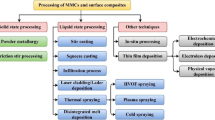Abstract
The performances of carbon nanofiber (CNF) reinforced copper (Cu) composite electrodes on the reaction-bonded silicon carbide (RB-SiC) ceramic were experimentally investigated by using electrical discharge machining (EDM). The effects of CNF content on material removal rate (MRR), electrode wear ratio (EWR), surface roughness (SR) and surface topography were examined. Results indicated that the addition of CNF to the Cu electrode increased the MRR of the workpiece. In addition, increasing the added CNF content increased the EWR of the Cu–CNF composite electrode and the SR of the machined surface. The results of one-way ANOVA indicated that the Cu–1.0 wt% CNF composite electrode exhibited the optimal MRR and EWR values, although this electrode resulted the maximum SR on the RB-SiC machined surface.
Similar content being viewed by others
References
Ji R, Liu Y, Zhang Y, Wang F (2011) Machining performance of silicon carbide ceramic in end electrical discharge milling. Int J Refract Met Hard Mater 29:117–122
Goel S, Yan J, Lou X, Agrawal A (2014) Incipient plasticity in 4H-SiC during quasistatic nanoindentation. J Mech Behav Biomed Mater 34:330–337
Chen S, Lin B, Han X, Liang X (2013) Automated inspection of engineering ceramic grinding surface damage based on image recognition. Int J Adv Manuf Technol 66(1–4):431–443
Feng J, Chen P, Ni J (2013) Prediction of grinding force in microgrinding of ceramic materials by cohesive zone-based finite element method. Int J Adv Manuf Technol 68(5–8):1039–1053
Lalchhuanvela H, Doloi B, Bhattacharyya B (2013) Analysis on profile accuracy for ultrasonic machining of alumina ceramics. Int J Adv Manuf Technol 67(5–8):1683–1691
Wei C, Zhao L, Hu D, Ni J (2013) Electrical discharge machining of ceramic matrix composites with ceramic fiber reinforcements. Int J Adv Manuf Technol 64(1–4):187–194
Puertas I, Luis CJ (2012) Optimization of EDM conditions in the manufacturing process of B4C and WC-Co conductive ceramics. Int J Adv Manuf Technol 59(5–8):575–582
Patel KM, Pandey PM, Venkateswara Rao P (2010) Optimisation of process parameters for multi-performance characteristics in EDM of Al2O3 ceramic composite. Int J Adv Manuf Technol 47(9–12):1137–1147
Patel N (2015) Review on importance of electrodes in electrical discharge machining process. Int J Res Aeronaut Mech Eng 3(10):36–41
Marashi H, Jafarlou DM, Sarahan AAD, Mardi NA (2016) Employing severe plastic deformation to the processing of electrical discharge machining electrodes. Precis Eng 46:309–322
Norliana MA, Noriah Y, Rohidatun M (2012) Electrical discharge machining (EDM): practices in Malaysian industries and possible change towards green manufacturing. Procedia Eng 41:1684–1688
ASM Handbook (1990) Machining. Volume 16. ASM International Publisher, ISBN: 978-0-87170-022-3
Jahan MP, Wong YS, Rahman M (2009) A study on the fine-finish die-sinking micro-EDM of tungsten carbide using different electrode materials. J Mater Process Technol 209:3956–3967
Tsai HC, Yan BH, Huang FY (2003) EDM performance of Cr/Cu-based composite electrodes. Int J Mach Tool Manu 43:245–252
Khanra AK, Sarkar BR, Bhattacharya B, Pathak LC, Godkhindi MM (2007) Performance of ZrB2-Cu composite as an EDM electrode. J Mater Process Technol 183:122–126
Yuangang W, Fuling Z, Jin W (2009) Wear-resist electrodes for micro-EDM. Chin J Aeronaut 22:339–342
Gill AS, Kumar S (2014) Surface roughness evaluation for EDM of En31 with Cu-Cr-Ni powder metallurgy tool. Int J Mech Aero Ind Mechat Manuf Eng 8(7):1308–1313
Larionova T, Koltsova T, Fadin Y, Tolochko O (2014) Friction and wear of copper – carbon nanofibers compact composite prepared by chemical vapor deposition. Wear 319:118–122
Liang J, Saha MC, Altan MC (2013) Effect of carbon nanofibers on thermal conductivity of carbon fiber reinforced composites. Procedia Eng 56:814–820
Liew PJ, Nurlishafiqa Z, Qumrul A (2017) Preparation and characterization of carbon nanofiber reinforced copper composite electrodes via powder metallurgy process for electrical discharge machining applications. Int J Appl Eng Res 12(10):2253–2261
Liew PJ, Yan J, Kuriyagawa T (2013) Carbon nanofiber assisted micro electro discharge machining of reaction-bonded silicon carbide. J Mater Process Technol 213:1076–1087
Liu Y, Ji R, Li Q, Yu L, Li X (2008) Electrical discharge milling of silicon carbide ceramic with high electrical resistivity. Int J Mach Tools Manuf 48:1504–1508
Ji R, Liu Y, Diao R, Xu C, Li X, Cai B, Zhang Y (2014) Influence of electrical resistivity and machining parameters on electrical discharge machining performance of engineering ceramics. PLoS One 9(11):e110775. https://doi.org/10.1371/journal.pone.0110775
Hascalik A, Cydas U (2007) Electrical discharge machining of titanium alloy (Ti-6Al-4V). Appl Surf Sci 253:9007–9016
Erden A, Bilgin A (1980) Role of impurities in electrical discharge machining. IMTDR Conference. 345–350
Funding
The authors would like to thank the Ministry of Higher Education Malaysia and Universiti Teknikal Malaysia Melaka (UTeM) for financial and technical support through the grant RACE/F3/TK4/FKP/F00300.
Author information
Authors and Affiliations
Corresponding author
Rights and permissions
About this article
Cite this article
Liew, P.J., Nurlishafiqa, Z., Ahsan, Q. et al. Experimental investigation of RB-SiC using Cu–CNF composite electrodes in electrical discharge machining. Int J Adv Manuf Technol 98, 3019–3028 (2018). https://doi.org/10.1007/s00170-018-2417-8
Received:
Accepted:
Published:
Issue Date:
DOI: https://doi.org/10.1007/s00170-018-2417-8




